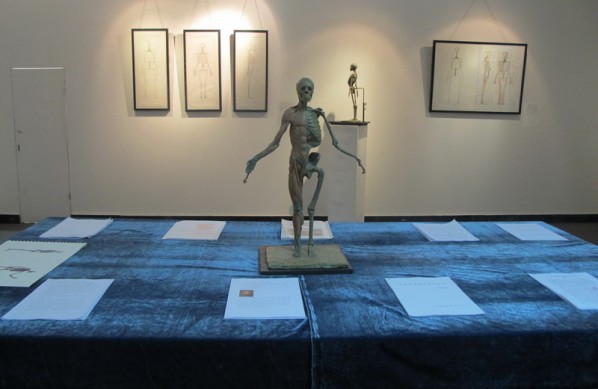
Themed “Anatomy” Reporting Exhibition of the Anatomy Course of Grade 2 organized by the Department of Oil Painting, CAFA, was inaugurated at the Main Building Exhibition Hall in Building No.5, CAFA, at 11:00am on November 26, 2012.
The Department of Oil Painting has unfolded a series of exhibitions of basic teachings, after holding “Constructing a City by Dots and Lines: Reporting Exhibition of the Urban Perspective Course from the 2nd Studio of the Department of Oil Painting, CAFA” at the Main Building Exhibition Hall in Building No.5, CAFA, on October 29 - November12, 2012, the 2nd exhibition themed “Anatomy” was held. It displayed 15 pieces of sculptures in total, including three-dimensional human skeleton models of 64cm high, plans of human skeletons, as well as 9 thesis from different directions.
Cao Yi, teacher from the Department of Oil Painting, guided the exhibition, along with works that were guided by two foreign teachers, experts of artistic anatomy. Prof. Laura Frazure from the Art Institute of New York City, and Prof. Michael Rossman from the Art Institute of Philadelphia were invited to give lectures by the Department of Oil Painting. And the professors unfolded a two-month three-dimensional anatomical course for postgraduates, whose works are shown too.
When conceptual art was popular in the 1980s, Contemporary American anatomy teaching was introduced as part of the teaching system of art institutes, and then developed. The Golden Figure was one of the academic authorities of contemporary American artistic anatomical research, established by Andy Warhol, also one of the founders of the Art Institute of New York City in the 1980s. It clearly proved that, even though conceptual art would prevail, the elite artists still considered artistic anatomy as a necessary part of artistic development, rather than an anatomical technology or a outdated discipline.
[gallery link="file" orderby="title"]
The contemporary artistic anatomy course, absorbing the experiences of international artistic anatomy teaching, attempted to improve students’ plastic abilities and understandings of art in the perspective of anatomy, and inspires students to commence professional art research while studying independently. It led students to study the structure of bones and muscles in the whole body to improve better plastic models, by mainly studying three-dimensional human anatomy. Three-dimensional thinking is originated from the Western aesthetics system, playing an important role in not only the traditional graphic forms like oil paintings, but also sculptures or abstract language, however, a lot of Chinese students see two-dimensional spaces, and even create two-dimensional sculptures. The Three-dimensional anatomy course will help students transform their two-dimensional thinking to a three-dimensional one, understanding how to see three-dimensional objects, and express them in the two-dimensional media. In addition, the course involved the plastic languages of the art of the body. The relationship of artistic anatomy and the development of art history stresses that students must study artistic anatomy, which is a way to understand the fundamental elements and history of art once again.
The content of the course included: works being constructed according to the proportion of the artistic human body of 7.5-head high, and other parts of the body were constructed according to this proportion too. Initially a student constructed it in a basic form with fixed proportions, gradually it reflected real bone structure. Using the relationship of the connections of bones and gravity, and movement, they displayed the movement and the plasticity of human bones with the features of moving trends, joints and movements, as well as individual muscles, muscle groups and appendages. Finally, there were case analysis on some artists’ works, and the performance languages (plastic languages) formed by integrating the surface and the inner parts of the human body.
Students from the Department of Oil Painting have understood the structure and proportion, and motion principles of human bones, by studying and producing human body models of 60cm high. By introducing the meaning and purpose of the study of “artistic human proportion”, students recognized that they would explore how to recognize the body rather than illustrating the body in the anatomy course.
The exhibition lasts until December 10, 2012.
Text by the Department of Oil Painting
Photography by Gao Sisi/ CAFA ART INFO
Translated by Chen Paihua/ CAFA ART INFO




























